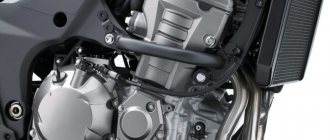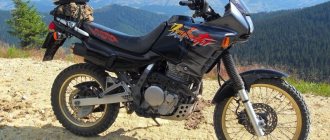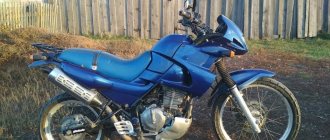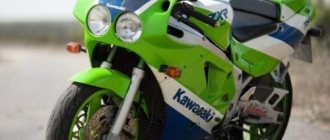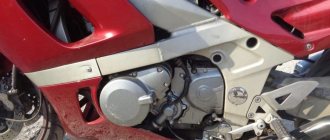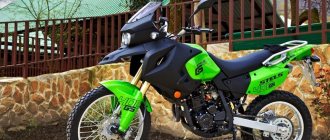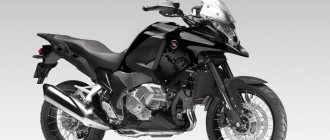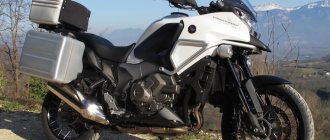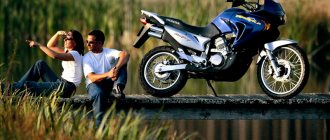- Kawasaki motorcycle model
The Kawasaki KLE 400 touring enduro model was first introduced in 1991. The motorcycle is built on the basis of the export version of the Kawasaki KLE 500 and the engine from the sports Kawasaki GPZ400S (later installed on such models as the Kawasaki EN400 Vulcan and Kawasaki EX-4). The Kawasaki KLE 400 was aimed at the domestic Japanese market and was not officially supplied to other countries. In fact, the model is the first generation KLE500 with a 400 cc engine.
Despite its rather interesting concept and generally low price, the Kawasaki KLE 400 was not particularly popular in Japan. This forced the company to suspend production of the motorcycle by 1995, resuming production only in 1999, which was the last year of the model’s life on the market. The remainder of the new motorcycles in the warehouse continued to be sold off until 2001.
Features of the Kawasaki KLE 400 include an in-line 2-cylinder engine, a steel tubular frame, disc brakes, a 15-liter fuel tank, long-travel suspension, a 6-speed gearbox and 178 kg of dry weight.
Engine
The engine here is in-line, four-stroke and two-cylinder. Not a very common solution for this class. The working volume of the unit is 398 cm³. The maximum characteristics are as follows: at 8000 rpm the torque reaches 33 Nm, and at 9000 rpm the power is 42 hp. This determines the maximum speed of 160 km/h.
Brief history of the model
1991 - start of production and sales of Kawasaki KLE 400. Model: Kawasaki KLE400 (Japan). Factory designation: KLE400-A1. Color: Silver with a purple saddle (Metallic Violet Royal).
1992 - no significant changes. Model: Kawasaki KLE400 (Japan). Factory designation: KLE400-A2. Color: Blue with Blue Seat (Metallic Sonic Blue).
1993 - no significant changes. Model: Kawasaki KLE400 (Japan). Factory designation: KLE400-A3. Color: Blue with Blue Seat (Metallic Sonic Blue).
1994 - no significant changes. Model: Kawasaki KLE400 (Japan). Factory designation: KLE400-A4. Color: Metallic Meadowmist Green with black seat.
1995-1998 - the model is not produced. 1999 is the last year of production of the model. Model: Kawasaki KLE400 (Japan). Factory designation: KLE400-A6. Color: white with black seat (Metallic Champagne Gold).
Dimensions and weight
The weight of the motorcycle without fuel is 178 kg. The gas tank capacity is 15 liters. At a speed of 60 km/h, consumption per 100 km will be 2.74 liters, and therefore the relatively small tank volume is quite justified, because it makes the bike lighter. The model reaches 2210 mm in length, 1215 mm in height, 870 mm in width. The seat height is 840 mm, and the wheelbase dimensions are 1500 mm.
Year of release
The Kawasaki KLE 250 touring enduro model was produced without any changes throughout the entire production period.
It was published in 1993 , but did not have the expected success. Sales in the Japanese market are weak . Exporting the model to European countries does not help the situation. The developers are talking about closing production and stopping it several times. Finally, in 2001 , the model finally went down in history.
Although the model belongs to the enduro tour, users note that from this proud name there is only a large suspension travel (117 - front, /200 - rear), high ground clearance and engine protection.
If not for these details, the motorcycle could be classified as a road bike.
Chassis and brakes
The Kawasaki KLE 400 is equipped with a tubular steel frame. For this motorcycle, this is perhaps a plus. Its design is stylish, especially pleasing is the dull metallic shade, which gives the bike some kind of gloss and originality. Spoke wheels come in handy. The medium-sized steering wheel will be comfortable for both those who are accustomed to sports motorcycles and those who have been riding cruisers for a long time.
The rear pendulum suspension has a monoshock absorber. Preload is adjustable. The suspension travel is 200 mm. The front suspension is represented by a telescopic fork with a stroke of 220 mm. Its dimensions are 41 mm. The rear brakes are a single 230mm disc with a single-piston caliper. At the front there is also one disc, but its dimensions are 300 mm, and the caliper is two-piston.
Review of the Kawasaki KLE 400 motorcycle
The moto is quite high in the saddle, and as for the ground clearance, it is quite enough to overcome curbs and small littered trees, which promised a fairly wide use of this device, both in the city and on the countryside, without bothering too much with the quality of the coating. Another advantage of a high seating position is good visibility in city traffic. The seating position is comfortable, straight, with my height of 183 I can confidently reach the ground with my feet, the saddle is moderately hard and narrow, which makes it possible to freely pilot the motorcycle “in a standing position.” The brakes are quite sufficient, but reinforced hoses will not be superfluous. In terms of wind protection, I would give a C, because... at speeds above 90 mph, the standard windshield stops coping, but with arms growing out of the right place, this problem can be solved by making a new windshield from plexiglass. The engine is reliable and unpretentious, both in particular and in terms of the quality of gasoline; in the absence of the 95th, the 92nd uses it with a bang (I didn’t notice any difference ), the only thing is that it is quite gluttonous (approximately 8 liters per hundred) and noisy (not in terms of exhaust, but in operation), and the fact that it comes from an ancient sport is rather a peppercorn, which some will like, but others will not. Personally, I’m used to its non-enduric enthusiasm (it helps a lot in the city) and the 6-speed gearbox. In the city and on hard ground, at a calm pace of movement, I simply switch gears through one, and when passing through mud obstacles, the first gear is almost a lower gear (at least with my weight of 85 kilos), this is me in defense of statements about the missing bottoms. I didn’t experience the lack of lower levels. I’ll also say this, this motorcycle is not intended for sports enduro, the dry weight of 170 kg (even with toothy tires) will give you the opportunity to sweat properly if the bike is sat on its belly in some kind of liquid, so my advice is frankly not climb in. Regarding the suspension: it’s better to immediately set the rear shock to the hardest position, as for the front fork, I pump 2.2-2.5 points into it, it’s quite rigid and controllable. When using a motorcycle in forest rides, it is better to increase the front fender (make it from a piece of car locker a la mudguard) by 8 centimes, this will avoid rapid clogging of the radiator. The plastic is scratchy and likes to rattle at low speeds (this can be cured, but I don’t bother, I’m used to it) ), it is better to install protective arches that will cover it. The instrument panel is easy to read both day and night, the buttons on the remote control are in their place (you don’t have to reach for them), the headlights are at a confident 4, if you wish, you can install additional lights, but it won’t take long to tear them off in the forest. On the highway, the cruising 110-120kemeche is quite comfortable for both the bike and the rider; when overtaking, the engine is dull, you have to click down, but it’s four hundred.
In conclusion, I will say that the motorcycle is easy to maintain, very forgiving in handling (except for stupidity, of course), and convenient for the city and trips to the country. Not too powerful, but quite enough to carry a passenger and luggage. Again, I repeat, this is not a Dakar projectile and it will not be suitable for fishing for tens of thousands of kilometers, at least with the second number (you should not want from it what it is not intended for). He is a faithful friend and comrade, like good old JAVA, which is always remembered with warmth. Plus, it offers great opportunities for little money.
I’ll start with the bad, the consumption is very different; in the forests I got about 8 liters per hundred (20 km of hard wood without slurry and 80 asphalt) in the city the consumption was about 5.5-6 liters. The engine spins great (after all, it contains the ancestor of a sportbike worth it) the biggest disadvantage is the complete lack of traction at the bottom (that is, the gas is minimal when driving through sand, mud, horseradish will be trampled, you have to fire the clutch).
The driver's seating position was just right; the car had a low windshield, but it still worked at a speed of 120; it was noticeable if you bent over it a little. IT IS VERY PROBLEM LOOKING FOR REAR TIRES 17 RADIUS (as in Africa, broadcast, pimp) tires are sold out so quickly. The terrible muffler pipes are ordinary metal that rusts; nothing can be done with them; the paint burns (only probably chrome plating, but this is difficult and even unrealistic for an ordinary person). I was very pleased with the instrument panel, I drove mainly only by the tachometer, fortunately it was there))))))). The brakes are awesome, better than on the enduro chekushki but worse than on the SIBI 400 sf (I drove both). It’s easy and good to drive with two people, only the rpm is 1000 more so that acceleration and speed are good (compared to when driving alone). The plastic is very cracky and brittle - I advise you to take care of it. A very incorrect air filter - no matter how Japanese designed it, dust will in any case be sucked in no matter how much or tumbled, poor design of the filter box. I don’t know why there are air vents from the headlight fairing to the frame (there are two large intestines), dirt, water and other crap flies there, and it all ends up exactly in the recesses for the spark plugs. Heavy iron pendulum, rear suspension is adjustable by the weight of the driver (I wanted to install it with adjustment... I wanted it... I wanted it... but I sold it). The fork is very flimsy, very thin for such a wheel (you need a 3rd yoke for rigidity). The motorcycle is very heavy for sand, but on the road it’s not noticeable, you can ride over curbs, but you don’t want to feel the weight of 160 kg falling off the curb. During the entire time of my ownership, I drove about 3 thousand (I still regret very, very little), in principle it never let me down, if not for its already ruined condition, I sold it because of 2 things, heavy and spent a lot.
Flaws
The bike does not have a windshield; some owners installed a homemade windshield made of impact-resistant polystyrene.
- Weak headlights - the near one is no good at all, the distant one is nowhere.
The narrow rectangular headlight is housed in a small plastic fairing.
- Unfortunate geometry for enduro - high pegs, low handlebars;
- Despite the use of steel during development, the front crossmembers are flimsy.
- The rear brake foot is poorly placed - close to the footrest, which causes it to bend, but at the same time far from the body of the bike - a falling branch or foliage can squeeze it out. At any speed, a sharp squeeze leads to the expected result - a fall.
There are conflicting opinions about the saddle. Some note that it is large and comfortable, others that it is narrow and uncomfortable on long trips.
According to users, the seat is tolerable for the first 50 kilometers, then thoughts arise about replacing it.
Advantages
- The main thing is the narrowness of the bike, which is convenient for shooting between rows. This also includes high-positioned mirrors - higher than the ears of most neighbors on the road.
- Low center of gravity.
- Excellent maneuverability, although the turning radius is quite large - the design of the steering wheel.
- Inexpensive maintenance.
- On light off-road conditions without slowing down.
No problems in a straight line, not bad along the radius if you don’t play with the gas.
At the rear there is a full set of lighting equipment and a stock trunk.
Specifications
The heart of the bike was the engine, which had already proven itself on a racing motorcycle of its own production, the ZXR400.
Engine – left view.
Engine – right side view.
Cylinder block.
Exhaust manifold.
As is customary on 400s, the engine’s power was reduced to 53 horsepower, due to which they were able to increase torque at low and mid-range speeds, which overall led to good dynamics for the newcomer.
Other parameters include:
- working volume - 398 cm3;
- number of cylinders - 4;
- number of cycles - 4;
- number of valves - 16 (4 per cylinder);
- power - 53 hp;
- torque - 36 Nm;
- cooling - liquid;
- fuel supply - Keihin carburetor, 4x (CVKD30);
- ignition - transistor (TDI);
- start - electric starter;
- tank volume - 14 l.
Users noted that the choice of prototype for the motor was not the best. He had his childhood problems - they moved on to the new bike. At the same time, it was noted that the parent was exported, so finding parts for repairs would not be a problem.
Transmission and clutch
Gear shift foot.
Chain drive.
a 6-speed gearbox is installed on a bike with a claim to racing participation . Installed here, coupled with the ZXR400 , it worked well and shifted smoothly. But from such a tandem the motorcycle received one small problem - second gear. As users note, she doesn’t like her motorcycle and, if possible, tries to get rid of her. Either go to neutral, or demand a higher one.
- Multi-disc clutch, oil bath . Power transmission is a cable .
- The main drive is a chain .
Brakes
Front brakes.
Rear brake.
Rear brake drive.
To describe the brakes in one word - ZX-9R (the brand's racing model, released around the same years). On a 5-point scale, they cope with their role perfectly.
Front:
- number of disks - 2;
- disc diameter - 310 mm;
- support - 2-piston.
Rear:
- number of disks - 1;
- disc diameter - 250 mm;
- support - 1-piston.
Options were not yet developed at the time of production.
